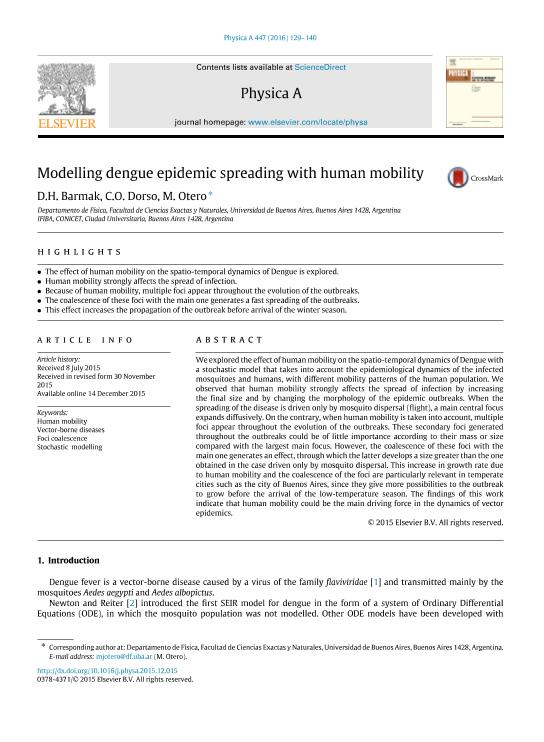Mostrar el registro sencillo del ítem
dc.contributor.author
Barmak, Daniel Hernan

dc.contributor.author
Dorso, Claudio Oscar

dc.contributor.author
Otero, Marcelo Javier

dc.date.available
2018-06-07T17:14:16Z
dc.date.issued
2016-04
dc.identifier.citation
Barmak, Daniel Hernan; Dorso, Claudio Oscar; Otero, Marcelo Javier; Modelling dengue epidemic spreading with human mobility; Elsevier Science; Physica A: Statistical Mechanics and its Applications; 447; 4-2016; 129-140
dc.identifier.issn
0378-4371
dc.identifier.uri
http://hdl.handle.net/11336/47684
dc.description.abstract
We explored the eect of human mobility on the spatio-temporal dynamics of Dengue with a stochastic<br />model that takes into account the epidemiological dynamics of the infected mosquitoes and humans, with<br />dierent mobility patterns of the human population. We observed that human mobility strongly aects<br />the spread of infection by increasing the nal size and by changing the morphology of the epidemic<br />outbreaks. When the spreading of the disease is driven only by mosquito dispersal (<br />ight), a main<br />central focus expands diusively. On the contrary, when human mobility is taken into account, multiple<br />foci appear throughout the evolution of the outbreaks. These secondary foci generated throughout the<br />outbreaks could be of little importance according to their mass or size compared with the largest main<br />focus. However, the coalescence of these foci with the main one generates an eect, through which the<br />latter develops a size greater than the one obtained in the case driven only by mosquito dispersal. This<br />increase in growth rate due to human mobility and the coalescence of the foci are particularly relevant<br />in temperate cities such as the city of Buenos Aires, since they give more possibilities to the outbreak<br />to grow before the arrival of the low-temperature season. The ndings of this work indicate that human<br />mobility could be the main driving force in the dynamics of vector epidemics.<br />Keywords: Human mobility, vector-borne diseases, foci coalescence, stochastic modeling
dc.format
application/pdf
dc.language.iso
eng
dc.publisher
Elsevier Science

dc.rights
info:eu-repo/semantics/openAccess
dc.rights.uri
https://creativecommons.org/licenses/by-nc-sa/2.5/ar/
dc.subject
Epidemiology
dc.subject
Dengue
dc.subject
Human Mobility
dc.subject
Morphology
dc.subject.classification
Astronomía

dc.subject.classification
Ciencias Físicas

dc.subject.classification
CIENCIAS NATURALES Y EXACTAS

dc.title
Modelling dengue epidemic spreading with human mobility
dc.type
info:eu-repo/semantics/article
dc.type
info:ar-repo/semantics/artículo
dc.type
info:eu-repo/semantics/publishedVersion
dc.date.updated
2018-06-01T13:56:12Z
dc.journal.volume
447
dc.journal.pagination
129-140
dc.journal.pais
Países Bajos

dc.journal.ciudad
Amsterdam
dc.description.fil
Fil: Barmak, Daniel Hernan. Consejo Nacional de Investigaciones Científicas y Técnicas; Argentina. Consejo Nacional de Investigaciones Científicas y Técnicas. Oficina de Coordinación Administrativa Ciudad Universitaria. Instituto de Física de Buenos Aires. Universidad de Buenos Aires. Facultad de Ciencias Exactas y Naturales. Instituto de Física de Buenos Aires; Argentina
dc.description.fil
Fil: Dorso, Claudio Oscar. Consejo Nacional de Investigaciones Científicas y Técnicas. Universidad de Buenos Aires; Argentina
dc.description.fil
Fil: Otero, Marcelo Javier. Consejo Nacional de Investigaciones Científicas y Técnicas. Universidad de Buenos Aires; Argentina
dc.journal.title
Physica A: Statistical Mechanics and its Applications

dc.relation.alternativeid
info:eu-repo/semantics/altIdentifier/url/http://www.sciencedirect.com/science/article/pii/S0378437115010420
dc.relation.alternativeid
info:eu-repo/semantics/altIdentifier/doi/http://dx.doi.org/10.1016/j.physa.2015.12.015
Archivos asociados
